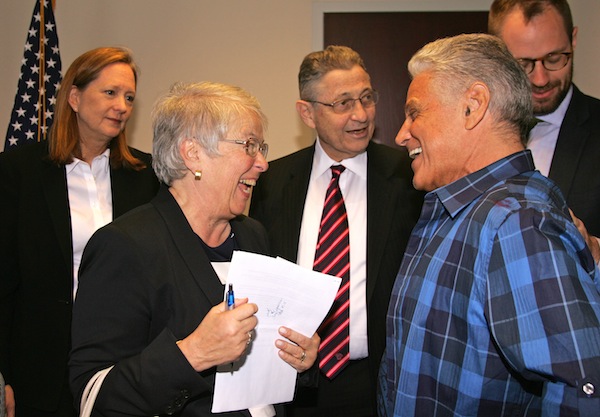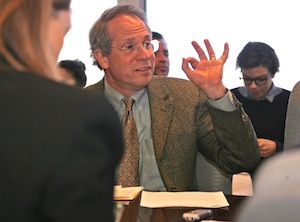
BY SAM SPOKONY | A year after a similar visit from her predecessor led only to more frustration, Schools Chancellor Carmen Fariña came to Assembly Speaker Sheldon Silver’s office on April 24 to hear Downtown school advocates’ desperate pleas for action on the district’s overcrowding problem.
In attending the monthly meeting of Silver’s Schools Overcrowding Task Force, Fariña clearly hoped to set a different tone than that carried by ex-Chancellor Dennis Walcott and the Bloomberg administration.
“We believe in parents and community members being an important part of decision making,” said Fariña, who added that she already “know[s] a lot of the issues” facing School District 2 because she was previously principal of P.S. 6 (which, although it is in District 2, is located on the Upper East Side).
The new chancellor started by stressing that her presence at last week’s meeting was really about “listening and taking notes,” and she did not go on to make any commitments or engage in any substantive discussions.
“I really want to hear from you about what your priorities are, and how we can help,” she said.
And, as always, there was much to hear from Downtown principals, advocates and elected officials.
The kindergarten waitlists may not be as massive this year as they were last year, but it’s clear that most local schools are close to bursting at the seams, and they’re taking on additional classroom sections to bear the burden of Downtown’s ever-growing residential population.
Lisa Ripperger, principal of Tribeca’s P.S. 234, said she’s expecting to fill an all-time high of 175 kindergarten seats, in seven sections, and added that she’s “really hoping for more cancellations” when it comes to the 210 seat offers her school has already made.
Terri Ruyter, principal of Battery Park City’s P.S. 276, followed by stating that her school will be waitlisting 52 zoned families, even while increasing to four kindergarten sections and eliminating pre-K after carrying two sections in 2012 and one section last year.
“We just don’t have the real estate,” Ruyter said of cutting out the pre-K. “We’re out of room.”
Maggie Siena, principal of the Peck Slip School (which is currently in temporary rooms at the Tweed Courthouse), said she’ll also be losing pre-K due to lack of space, after picking up 25 kindergarten students from the P.S. 276 waitlist while also making 80 seat offers within the school’s zone.
“We’ll be all filled up, and we’re going to be sharing rooms,” she added.
And although those announcements, among others, seemed to call for a renewed sense of urgency, Fariña did not seem overly worried about the situation.
“I think this year in particular, you’re going to see waitlists kind of disappear over time, for any number of reasons…even though I know, this is the time [of year] when you get a little nervous about that,” the chancellor told to the principals.
Last year the elementary schools in Community Board 1 initially had 148 kindergarteners on waitlists, but that number dropped to zero as some found space in nearby schools, while most others either enrolled in public Gifted & Talented programs, private schools or they moved away.
One option which ended up not being needed last year — adding a kindergarten class in Tribeca’s P.S. 150 — presumably could be part of the solution this year, although there was no talk of specific solutions for P.S. 276 waitlisted families at last week’s meeting.
Fariña did compare the Downtown situation more generally to school struggles across the city.
“What we’re finding is that parents are applying to more than one place, and they’re looking to see what else is going to come down the pike, down here [in Lower Manhattan] in particular, and you also have parents who’ve applied to independent schools, or other schools,” she said. “So I think, for the first time, you’re actually not going to see any kindergarten child not have a space, and we’re seeing that citywide.”
But, as they have many times before, task force members pointed out that the kind of city- or borough-wide “averaging” long used by the Department of Education in its school seat projections has continually failed the Downtown community.

“The fact is that demand in 2014 is already where we expect supply to be in 2018, and that’s a serious imbalance,” said Eric Greenleaf, a former P.S. 234 parent and local statistics expert who was also recently appointed to Mayor de Blasio’s new school space task force, dealing with the future co-locations in public schools.
Greenleaf explained that according to his projections ― based on Downtown’s well-documented boom of both new births and residential development ― by 2018, elementary schools in Community Board 1 will be around 1,350 seats behind demand. And that’s including D.O.E.’s planned new 456-seat school in the district, which has yet to be sited and which all the advocates have already fretted over, after expecting 1,000 new seats below Canal St. in the Department’s five year capital budget, following last year’s visit from ex-Chancellor Walcott.
“Whenever we’ve said 1,350, D.O.E. has repeatedly said zero,” said Greenleaf, referring to the Department’s refusals to acknowledge his projections in past years. “There’s a big difference between 1,350 and zero. That’s why the D.O.E.’s forecasts aren’t working, and they need to be fixed. So please, we need more schools. The one school is appreciated, but it’s nowhere near enough.”
State Sen. Daniel Squadron, who also attended the Thursday meeting, didn’t hold back in his support of the local stats guru.
“What [Greenleaf] says has proven again and again to be true, and we really need the Department to look at projections differently, certainly [Downtown] where you’re seeing all these changes,” Squadron said directly to Fariña.
“His numbers, if you take history as any guide, are going to come true,” the state senator added, In his own closing remarks, Silver reiterated the need for 1,000 new school seats in D.O.E.’s new capital plan ― along with speedy siting and construction ― in order to have them online by 2017 or 2018.
Aside from stating that she acknowledged the request and “circled” 2017, presumably in her notes, Fariña did not comment on the prospect of getting 1,000 new seats below Canal St. into the capital plan, nor on any planned changes to how D.O.E. will make its projections in the ever-increasing residential neighborhoods of C.B. 1.
After the meeting, Shino Tanikawa, president of School District 2’s Community Education Council, summed up the chancellor’s visit with extremely guarded optimism ― if it could even be called that.
“Well, it’s a better tone, and this is a new administration that’s a lot friendlier, but I think the chancellor still has to understand that we have a problem here,” said Tanikawa, who reacted to Fariña’s apparent complacency regarding Downtown waitlists by stressing that those waitlists were kept low only because local schools took on extra kindergarten sections and maxed out their available space.
“So we might start seeing the loss of art rooms or other rooms, because these kindergarten kids are going to move up, and they’re going to run out of space, and that’s the thing that I don’t think [Fariña] quite gets,” Tanikawa. “It’s not a sustainable model, so you can’t celebrate anything about the waitlists being lower, and you can’t call it a victory.
“We still have a long way to go,” she mused.






























